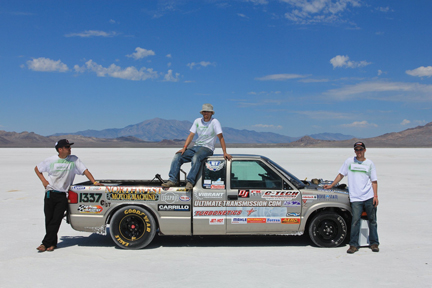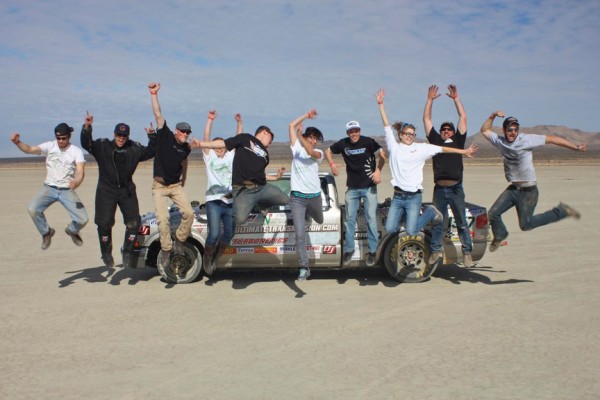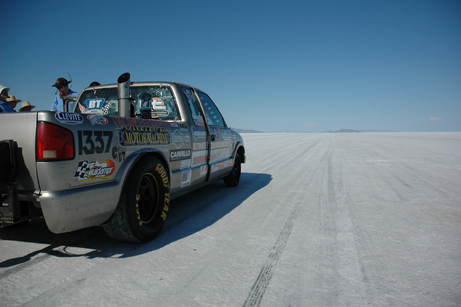Greenspeed is a group of seven students at Boise State University who are on a mission to create the world’s fastest vegetable oil-powered vehicle. Where did they come up with such an idea?
Dave Schenker, the president of Greenspeed, explains that about ten years ago he heard about, “some old guys who were running a ‘vintage’ Mercedes Benz on vegetable oil”. He was intrigued. He then spent several years experimenting with diesel hot rods.  His quest to fully understand the science involved led him to engineering school. So fifteen years after his formal (home school) education had ended, Dave decided to study engineering at Boise State. He spent some time as an undergrad researcher in the material science department, which helped him stay hands-on, but he couldn’t shake the call of the racing world, and he remembered the “two old guys and their vegetable oil”. An extensive search revealed an interesting number; the top speed ever recorded for a vegetable oil-powered vehicle was only 98 mph!
His quest to fully understand the science involved led him to engineering school. So fifteen years after his formal (home school) education had ended, Dave decided to study engineering at Boise State. He spent some time as an undergrad researcher in the material science department, which helped him stay hands-on, but he couldn’t shake the call of the racing world, and he remembered the “two old guys and their vegetable oil”. An extensive search revealed an interesting number; the top speed ever recorded for a vegetable oil-powered vehicle was only 98 mph!
As a full-time student, Dave could no longer afford the racing toys he was used to, but the concept of an officially-sanctioned student club at Boise State offered the means to raise both interest among his fellow students and the sponsorships and donations required to fund the endeavor. In 2010 the group achieved official “student club” status, and in 2011, their third year, things began to happen fast: In March, the students, with the help of a generous donor, bought a 1998 Chevy S-10. In late May, some shop space was donated, and by August they had completed their first high-speed run. In less than three months, the club had raised enough donations (in cash & parts) had completed the overhaul and construction of the truck from the ground up, and made it to the salt flats for a pair of high speed runs!
Class Rules
Diesel trucks compete for top speed records in several classes: Unlimited Diesel Truck (UDT), Modified (MDT), Highway Hauler (HH), and Diesel Truck (DT) class, with various engine sizes allowed per class (from AA to F). The fastest time recorded for any vehicle operating on vegetable oil happened to be for an unlimited class truck at 98 mph. But this time was not considered an official world record, as there is no separate distinction for the various fuel types. Greenspeed competes with a class “C” engine in the DT category or CDT for short. The top speed for a CDT class vehicle, regardless of fuel type, currently stands at 215.091 mph (set by a truck running on petroleum diesel).
Greenspeed originally petitioned the sanctioning body, the Southern California Timing Association, (SCTA) to allow vegetable oil vehicles to be considered as a separate class, but their petition was declined. The SCTA ruled that vehicles running on vegetable oil aren’t eligible for a separate world record, but can compete for an “official time”. [Now, after seeing the success of the Greenspeed team last year, the sanctioning body has changed the rules to officially allow the use of vegetable oil in the same classes with petroleum diesel and biodiesel.] It’s hardly an advantage though, as the team reports that, on average, vegetable oil has only about 90-95% of the energy contained in a comparable amount of petro-diesel.
Aerodynamics
The sanctioning body allows significant changes to all vehicles in the interest of safety, but in the DT class there are significant aerodynamic restrictions. The DT Class rules stipulate that all the body panels must be identical to, and in the same physical relationship to each other as they are on the production version of that model truck. A custom air dam (under the front bumper), and an optional bed cover are the only allowed aerodynamic changes to the truck. The team performed a simple Computational Fluid Dynamics (CFD) analysis and used the results to optimize their air dam design, but ran out of time to mount the dam, and ended up using only the stock bumper. The team also studied the aerodynamics of covered and uncovered beds, collected lots of anecdotal evidence, and performed another CFD analysis, with various portions of the empty bed covered. But in addition to the severe time constraints, the team questioned the accuracy of their simple CFD model, and thus the results of the analysis. They feel certain that a bed cover would only make a few miles-per-hour of difference, one way or the other, at top speed and they look forward to collecting empirical data to back up the computer modeling. They ended up running with an open bed in 2011. 
Engine
Class C entries are limited to a six-liter displacement engine. Greenspeed choose a 12-valve Cummings 5.9 liter V6. It’s a “fully-built” drag race engine, with a custom twin turbo system. Greenspeed used a number of AutomationDirect ProSense® temperature and pressure sensors to monitor the engine, and transmission and vegetable oil temperatures, as heated vegetable oil burns more efficiently.
One of the most innovative aspects of the Greenspeed entry is their use of a pair of ProSense pressure sensors, a proportional valve, and a PID loop to control their turbocharger. The engine is most efficient, and produces the most power, when the primary turbo is pressurizing the intake at exactly 40% of the overall intake pressure. Greenspeed’s custom twin turbo consists of a primary (high volume, low pressure) turbo feeding into a secondary (low volume, high pressure) turbo. The secondary turbo has a waste gate that controls the pressure differential between the two turbos. Traditional waste gates use a spring regulator to control the pressure, but this doesn’t provide accurate control. Greenspeed fitted a proportional valve to act as the waste gate and monitor the differential pressure between the intake pressures and the exhaust. Adrian Rothenbuhler, the lead systems engineer, explains, “The closed-loop PID-controlled turbo charger regulator keeps the boost pressure at an optimal level to maximize engine power.”
Suspension
The front suspension uses the stock geometry with beefed up coil-over shocks to support the weight of the larger engine. The stock rear suspension was a leaf type, but Greenspeed wanted to make some major modifications to the rear end of the vehicle, mostly to accommodate a NASCAR style ‘quick-change’ rear end. The quick-change rear end allows the team to make adjustments to the final drive ratio very quickly between runs, but installing it required rebuilding the frame of the vehicle from the cab back. They selected a ‘four link’ suspension to complete the modifications to the rear of the truck.
Greenspeed also plans to automate the suspension, with the use of analog proximity sensors to measure the ride height at each corner of the vehicle. With known spring rates, and measured ride height, Greenspeed will be able to calculate the down force acting on the vehicle. As opposed to some other types of racing, if top speed is your goal, then the desired down force follows the Goldilocks principle: You want just enough down force to stay on the ground and have good steering response. Anything more is just slowing you down.
Greenspeed has done some preliminary testing on this concept, and even had the sensors mounted and wired in 2011, but this system was not operational (another casualty of their compressed building schedule). They have a two-phase plan to complete the implementation. In 2012, they plan to begin logging data from the sensors during each run and making manual adjustments to the ride height between runs to optimize down force at a particular speed. Beyond that, they hope to add actuators at each corner to dynamically control the ride height to optimize down force at all speeds. In both years, they will also be able to alert the driver if down force ever drops below a minimum threshold.
Events in 2011:
With just two and a half months to build their entry, the students transported the almost completed truck six hours from Boise to the Mecca of high speed, the Bonneville Salt Flats for Speed Week 2011. Once they arrived, they completed the build on the salt. They had to overcome several last minute issues but finally passed the technical and safety inspections the last night of the event, and made it to the start 50 minutes before the event ended where they completed the last two runs of the event (for any competitors) – but were unable to post any times or records. Everyone they met at Bonneville offered their encouragement; most were in disbelief of what the team had accomplished in the short time frame. The team returned to Boise, started fall classes the next day, and started preparing for the next event.
After spending some much needed time tuning the engine on a dynamometer, the team returned to the salt flats a month later for the “World of Speed” event. This time the team was much better prepared, and they passed inspection with flying colors. But on their first high speed run, at the half mile mark, at over 140 mph, two cylinders cracked, and thus ended any hopes for a record at that event.
Again the team returned home; this time with a major engine rebuild awaiting them, and only three weeks before the last event of the year at Bonneville, the World Finals, in October. The team and their sponsors pulled off a Herculean effort and had the truck ready to run, only to hear that the event was cancelled due to rain. Not to be deterred, the team reevaluated their options, crossed their fingers, and decided to make the 16-hour drive to the final SCTA event of the year in Southern California at the El Mirage Dry Lakebed. It was a risky decision: a very long drive, a questionable weather forecast, and a very short course. But it paid off handsomely: the first run on Saturday clocked in at 139.882 mph, followed on Sunday by a second run at 155.331 mph!
So, with considerable perseverance the team shattered the previous recorded top speed for a vegetable oil-powered vehicle. Team Greenspeed is looking forward to returning to Bonneville for Speed Week 2012 with all of the improvements; they also plan to outfit the truck to run biodiesel and petroleum diesel as well as vegetable oil. They even have their eyes on some oil that’s extracted from algae that has been grown at Boise State. With the dedication this team showed in 2011, it’s hard to image anything but a bright, fast and green future for these students.
Provided by Chip McDaniel
AutomationDirect
Disclaimer: AutomationDirect does not guarantee the products described in this article are suitable for your particular application, nor do we assume any responsibility for your product/system design, installation, or operation.
Originally Posted: March 1, 2012



